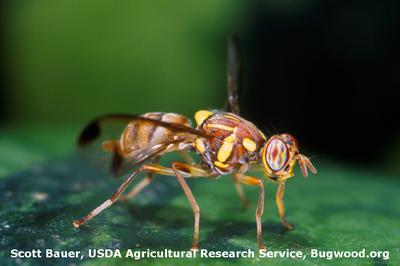Melon Fruit Fly
Zeugodacus cucurbitae
Mdudu
Kwa Ufupi
- Rotting and premature dropping of fruits.
- Small discolored patches on fruits.
- Seedlings, roots, stems and buds can also be attacked.
- Adults have a dark brown head, three bright yellow stripes on the back and transparent wings.
Inaweza pia kupatikana kwenye
Dalili
Females of Z. cucurbitae pierce the fruit skin when they lay their eggs. Larvae tunnel into the fruit. Considerable damage can occur inside the flesh (frass contamination, rotting). Small, discolored patches may develop on the fruit skin, where oviposition took place. The lesions, inflicted by the laying of eggs, make the fruits susceptible to secondary infections by opportunistic fungi and bacteria. Affected fruit will rot and often fall from the plant prematurely. Maggots also attack young seedlings, succulent tap roots of watermelons, and stems and buds of host plants such as cucumber, squash and others.
Mapendekezo

Udhibiti wa Kiasili
Post-harvest heat treatment (hot vapour or hot water) or cold treatments avoid the risk of contamination during and after transport. Wrap developing fruits with a protective cover or use traps baited with pheromones or protein (e.g. methyl eugenol which attracts male flies). Leaf extracts of ocimum sanctum (holy basil), which contain eugenol, beta-caryophyllene and beta-elemene, attract flies from a distance of 0.8 km when placed on cotton pads. Spraying these components combined with spinosad as poison will punctually kill flies in the orchard. Neem seed kernel extracts can be used as an oviposition deterrent.

Udhibiti wa Kemikali
Always consider an integrated approach with preventive measures together with biological treatments if available. Insecticides are moderatley effective against the fruit fly. Sprays should be mixed with protein baits, luring the flies to specific positions.
Ni nini kilisababisha?
Eggs are laid in groups under the skin of young fruits. Maggots are 10-12 mm long when fully grown, and cause damage by boring into the pulp of fruits. Pupation lasts 10 days, usually taking place in the soil, but occasionally in the fruits as well. The pupa develops in an oval, brown and 6-8 mm long nest. In very dry areas the pupae may enter diapause. Adults are 8-10 mm long with a dark brown head and three bright yellow stripes on the back. They feed on nectar, damaged fruit juice and plant sap. Wings are transparent with a dark brown stripe on the tip, spanning 12-15 mm. The life cycle takes 3-4 weeks and recurs many times per year.
Hatua za Kuzuia
- Plant resistant varieties, if available.
- The soil should be plowed regularly to either expose pupae to the sun or bury them deeply.
- Monitor the field regularly by using traps.
- Use traps to monitor or mass-catch adult flies.
- All unharvested fruits should be buried at least 0.5 m deep to ensure the death of the entire maggot population.
- Do not transport contaminated fruits to other locations.



